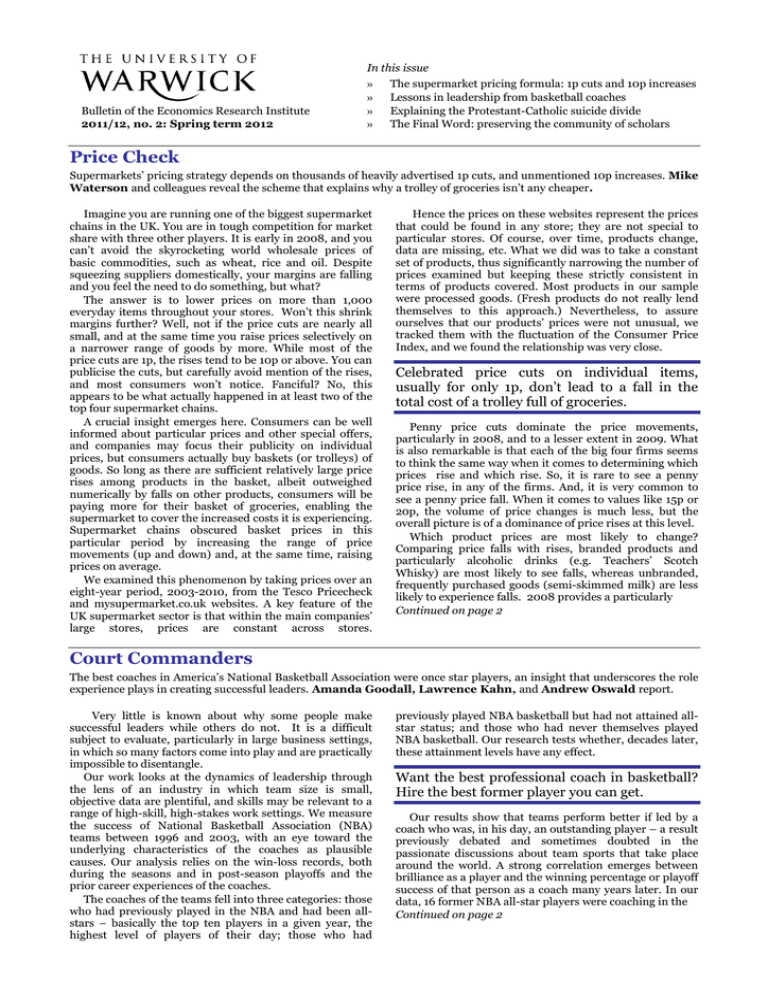The supermarket pricing formula: 1p cuts and 10p increases »
advertisement

Bulletin of the Economics Research Institute 2011/12, no. 2: Spring term 2012 In this issue » The supermarket pricing formula: 1p cuts and 10p increases » Lessons in leadership from basketball coaches » Explaining the Protestant-Catholic suicide divide » The Final Word: preserving the community of scholars Price Check Supermarkets’ pricing strategy depends on thousands of heavily advertised 1p cuts, and unmentioned 10p increases. Mike Waterson and colleagues reveal the scheme that explains why a trolley of groceries isn’t any cheaper. Imagine you are running one of the biggest supermarket chains in the UK. You are in tough competition for market share with three other players. It is early in 2008, and you can’t avoid the skyrocketing world wholesale prices of basic commodities, such as wheat, rice and oil. Despite squeezing suppliers domestically, your margins are falling and you feel the need to do something, but what? The answer is to lower prices on more than 1,000 everyday items throughout your stores. Won’t this shrink margins further? Well, not if the price cuts are nearly all small, and at the same time you raise prices selectively on a narrower range of goods by more. While most of the price cuts are 1p, the rises tend to be 10p or above. You can publicise the cuts, but carefully avoid mention of the rises, and most consumers won’t notice. Fanciful? No, this appears to be what actually happened in at least two of the top four supermarket chains. A crucial insight emerges here. Consumers can be well informed about particular prices and other special offers, and companies may focus their publicity on individual prices, but consumers actually buy baskets (or trolleys) of goods. So long as there are sufficient relatively large price rises among products in the basket, albeit outweighed numerically by falls on other products, consumers will be paying more for their basket of groceries, enabling the supermarket to cover the increased costs it is experiencing. Supermarket chains obscured basket prices in this particular period by increasing the range of price movements (up and down) and, at the same time, raising prices on average. We examined this phenomenon by taking prices over an eight-year period, 2003-2010, from the Tesco Pricecheck and mysupermarket.co.uk websites. A key feature of the UK supermarket sector is that within the main companies’ large stores, prices are constant across stores. Hence the prices on these websites represent the prices that could be found in any store; they are not special to particular stores. Of course, over time, products change, data are missing, etc. What we did was to take a constant set of products, thus significantly narrowing the number of prices examined but keeping these strictly consistent in terms of products covered. Most products in our sample were processed goods. (Fresh products do not really lend themselves to this approach.) Nevertheless, to assure ourselves that our products’ prices were not unusual, we tracked them with the fluctuation of the Consumer Price Index, and we found the relationship was very close. Celebrated price cuts on individual items, usually for only 1p, don’t lead to a fall in the total cost of a trolley full of groceries. Penny price cuts dominate the price movements, particularly in 2008, and to a lesser extent in 2009. What is also remarkable is that each of the big four firms seems to think the same way when it comes to determining which prices rise and which rise. So, it is rare to see a penny price rise, in any of the firms. And, it is very common to see a penny price fall. When it comes to values like 15p or 20p, the volume of price changes is much less, but the overall picture is of a dominance of price rises at this level. Which product prices are most likely to change? Comparing price falls with rises, branded products and particularly alcoholic drinks (e.g. Teachers’ Scotch Whisky) are most likely to see falls, whereas unbranded, frequently purchased goods (semi-skimmed milk) are less likely to experience falls. 2008 provides a particularly Continued on page 2 Court Commanders The best coaches in America’s National Basketball Association were once star players, an insight that underscores the role experience plays in creating successful leaders. Amanda Goodall, Lawrence Kahn, and Andrew Oswald report. Very little is known about why some people make successful leaders while others do not. It is a difficult subject to evaluate, particularly in large business settings, in which so many factors come into play and are practically impossible to disentangle. Our work looks at the dynamics of leadership through the lens of an industry in which team size is small, objective data are plentiful, and skills may be relevant to a range of high-skill, high-stakes work settings. We measure the success of National Basketball Association (NBA) teams between 1996 and 2003, with an eye toward the underlying characteristics of the coaches as plausible causes. Our analysis relies on the win-loss records, both during the seasons and in post-season playoffs and the prior career experiences of the coaches. The coaches of the teams fell into three categories: those who had previously played in the NBA and had been allstars – basically the top ten players in a given year, the highest level of players of their day; those who had previously played NBA basketball but had not attained allstar status; and those who had never themselves played NBA basketball. Our research tests whether, decades later, these attainment levels have any effect. Want the best professional coach in basketball? Hire the best former player you can get. Our results show that teams perform better if led by a coach who was, in his day, an outstanding player – a result previously debated and sometimes doubted in the passionate discussions about team sports that take place around the world. A strong correlation emerges between brilliance as a player and the winning percentage or playoff success of that person as a coach many years later. In our data, 16 former NBA all-star players were coaching in the Continued on page 2 Price Check from page 1 vivid example in many ways when compared with any of the other years. In 2008, the volume of penny price cuts became enormous and predicting which goods were most likely to see price rises and falls became even more difficult for consumers than in the other years. The supermarket price formula celebrates the 1p cuts and keeps quiet about the bigger price increases on selectively chosen goods. Summarising, competition between supermarkets, particularly at times of relatively rapid cost and price inflation, takes some unexpected forms. The focus of competition between supermarkets moves to implied indicators of good value, namely individual price reductions, rather than standard basket comparisons, in an apparent attempt to keep existing consumers moving Court Commanders from page 1 NBA; another 26 had played at less than an all-star level; another 26 of the coaches had never played NBA basketball. Former all-star players’ teams won 53.3 percent of their games, compared with 48.8 percent for teams coached by former NBA players who were not all-star players, and 44.5 percent for teams coached by those who never played in the NBA. When we study coaches in their first year with the team, the differences in success across different levels of the coaches’ playing ability are even more striking than for the sample as a whole. Former NBA all-star players have much higher average winning percentages and more playoff success than the other groups, and non-players have the least success of the three groups. Our research indicates that teams hiring former NBA players show steady improvement over four regular seasons and playoff competitions after the new coach’s arrival relative to their performance before hiring the new coach. But when a team hires a coach who never played in the NBA, team performance immediately deteriorates, and even after three to four years, it does not reach the levels attained before the coach’s arrival. For the performance of a team, the difference between having a coach who never played NBA basketball and the typical coach who played NBA all-star basketball is perhaps six extra places up the NBA league table. This is a considerable effect. (The league’s size was 29 teams in the period.) We control for player quality by using the team’s relative payroll, compared with other teams, for the given season. Our hypothesis is that better quality players earn higher salaries, which can then be used as an indicator of playing skill. Thus, player payroll is a proxy for the talent the coach has at his disposal. In the post-season playoffs, both categories of former NBA players have roughly comparable rates of success, and they are much higher than that of non-players. The difference in playoff success between former NBA players (former all-star and non-all-star players averaged together) and non-players is about 0.4 rounds in the playoffs, or almost one extra round every two years. Our analysis provides evidence that one predictor of a leader’s success is that person’s level of attainment – their “expert knowledge,” that is - in the underlying activity. In professional basketball, top players go on to make the best coaches. The “expert knowledge” effect that emerges from through their doors. As with many business areas, firms find it best to make comparisons difficult for consumers. Publication details This paper summarizes, "Pricing in inflationary times the penny drops," part of The Warwick Economics Research Papers series. The full paper is available at: http://www2.warwick.ac.uk/fac/soc/economics/research/ workingpapers/2011/twerp_975.pdf The authors Mike Waterson is an economics professor at the University of Warwick, where he focuses on the economics of retailing, competition policy and regulation and consumer behaviour. Ratula Chakraborty is the director of MSc programmes at the Norwich Business School at the University of East Anglia; Paul Dobson is the head of Norwich Business School at the University of East Anglia; and Jonathan Seaton is an economics reader at the School of Business and Economics at Loughborough University. our data appears to be fairly large. Moreover, it is visible in the data within the first year of a new coach’s arrival. A predictor of a leader’s success in a wide variety of fields is his or her level of attainment in that field by virtue of “expert knowledge.” It might be argued that the level of a coach’s acquired knowledge is not the driving force behind these results, but rather that some “tenacious personality” factor (or even a genetic component) is at work here, and this is merely correlated with both a person’s success as a coach and having been a top player in his youth. This remains a possibility. Nevertheless, there are reasons to be cautious of such a claim. One is that it is hard to see why Mystery Personality Factor X should not be found equally often among those particular coaches – all extraordinarily energetic individuals – who did not achieve such heights as players. If the coach’s skill as a player is the driving force behind the results that emerge from our analysis, there are different routes through which this effect could operate. First, it is possible that great players have a deep knowledge of the game and can impart that to the players they coach. It is also possible that this expert knowledge allows coaches who were better players to devise winning strategies since they may be able to “see” the game in ways that others cannot. In addition, once-great players may provide more credible leadership to the ego-heavy team members than coaches who were not great players – a factor that may be salient in other business endeavours involving high stakes, large egos and huge salaries. Publication details This article summarizes, “Why Do Leaders Matter? A Study of Expert Knowledge in a Superstar Setting,” published in the Journal of Economic Behavior and Organization. The full paper is available at: http://www2.warwick.ac.uk/fac/soc/economics/staff/aca demic/oswald/finaljebobasketballjuly2010.pdf The authors Amanda Goodall is a senior research fellow at the IZA Institute for the Study of Labor in Bonn and a visiting fellow at Cass Business School in London. Lawrence Kahn is a professor of economics and labor relations at Cornell University. Andrew Oswald is a professor of economics at the University of Warwick and a senior fellow at its Centre for Competitive Advantage in the Global Society (CAGE). 2 In Life and Death, Religion Matters Suicide rates are much higher in Protestant areas than in Catholic areas, even after taking account of differences in economic development and education. Sascha O. Becker and Ludger Woessmann explain why. As early as 1897 in the classic Le suicide, sociologist Émile Durkheim presented evidence that Protestantism was a leading factor linked to a higher incidence of suicide. Durkheim’s hypothesis was controversial then, and it remains so today. Yet, even now, Protestant countries tend to have substantially higher suicide rates, suggesting that the relationship between religion and suicide remains. Religious beliefs and the nature of a religious community play roles in determining whether someone will commit suicide. Our research investigates whether one’s religion is an influence in the decision to commit suicide, above and beyond other varied matters that may play a role, such as the weather, literacy, mental health and one’s financial situation. To examine the issue, we turn to data from Prussia in the 19th century. We look at the 19th century because this reflects the time period of Durkheim’s work and because religion was more pervasive at the time – in the sense that virtually everyone adhered to a religious denomination and that religion pervaded virtually all aspects of life. We look at Prussia because both Protestants and Catholics were non-minorities, living together in one state with a common setting of political governance, institutions, jurisdiction, language, and basic culture. The two religions give us a basis for comparison. In the archives, we found – and digitized – data from the Prussian statistical office for the years 1869-71, meticulously administered by local police departments, available at the level of the 452 Prussian counties and containing information on suicides. Census data from 1871 contain information about religion and relevant explanatory variables such as literacy and economic development. A distinct challenge in exploring the possible causal connection between suicide and religion is the chance that people who may be more prone to commit suicide may be more likely to choose one religious denomination over another as well. However, in our setting, individual changes of denomination hardly existed, and regional denominational variation derived from choices of local rulers made several centuries earlier. Prussia in the 19th century reveals trends that continue through modern times. During Reformation times, Protestantism spread in a roughly concentric fashion around Luther’s city of Wittenberg. As a result of this geographical pattern of diffusion, the share of Protestants is higher near Wittenberg – as is the suicide rate. Numerically, the difference in suicides between religious denominations in Prussia is huge: Suicide rates among Protestants (18 per 100,000 people per year) are roughly three times as high as among Catholics. These results are very strong and striking, even when taking into account differences in literacy, weather conditions, economic development levels, the share of people with mental health issues, and other determinants. The results remain strong even when taking into account the possibility that some suicides might have been deliberately under-reported and recorded instead as fatal accidents. The higher Protestant suicide rate is pronounced as early as 1816, our analysis of another unique data set shows. From an economic perspective, an individual contemplating suicide considers whether he believes the “optimal” choice is to continuing living or to end his life. Our results show that, from a theoretical perspective, three aspects of religious beliefs and practices underlie the higher suicide rates we found among Protestants than Catholics. Suicide rates among Protestants are three times the suicide rates among Catholics. First, as already suggested by Durkheim, Protestant and Catholic denominations differ in their group structure. Protestantism is a more individualistic religion. When life hits hard, a Catholic can rely on a stronger community, which might keep up his life spirit. Second, differences in theological doctrine between Protestants and Catholics appear to play a role. Protestantism stresses the importance of salvation by God’s grace alone and not by any merit of man’s own work, whereas Catholicism allows for God’s judgment to be affected by man’s deeds and sins. As a consequence, committing suicide entails the prospect of forgoing paradise for Catholics but not for Protestants. Third, Catholics (but not Protestants) consider the confession of sins a holy sacrament. Since suicide is the only sin that (by definition) can no longer be confessed, this creates an additional reason to deter Catholics from committing suicide. In sum, we conclude that suicide is affected by all these factors – the structure of the religious community, strongly held views about God’s grace, and the impossibility of confessing the sin of suicide. As a result, we conclude that religion matters, in life and death. Publication details: This article summarizes “Knocking on Heaven’s Door? Protestantism and Suicide,” available in The Warwick Economics Research Paper Series, number 966, at http://ideas.repec.org/p/wrk/warwec/966.html The authors: Sascha O. Becker is an associate professor of economics at the University of Warwick and deputy director at its Centre for Competitive Advantage in the Global Economy (CAGE). Ludger Woessmann is Professor of Economics at the University of Munich and Head of the Human Capital and Innovation Department at the Ifo Institute. 3 The Final Word Director Abhinay Muthoo contemplates a Maginot Line between the new tuition policies and the true community of scholars that makes a university such a unique place. In October 2012, an enormous change will take place at our university and on campuses throughout the UK. At that time, the fees to attend the University of Warwick will triple to £9,000 per year. The prelude to this new act in university life has been fraught with uncertainty, anger, and even danger at times, and no one knows exactly how the new funding paradigm will play itself out when it becomes a reality on campuses this fall. I believe we are on the cusp of a time during which everything will change and nothing will change. Let me explain. In the “everything changes” category, obviously, is the basic funding model that underlies the university degree. Under the new system, the student essentially will serve as a lone financial investor, providing the venture capital for a start-up business: the business of his or her own future career. Under the old model, UK taxpayers played the role of the student’s venture capitalists, paying for roughly two-thirds of the needed funding. A little-explored aspect of this policy shift is that while the students will be paying much more, the university will not be receiving any more. The money coming to the university next year will be roughly the same amount as it was this year. And there - where the tripling of the price of a university degree meets the status quo of the university budget - is the point where realities of policies that are radically changing in one sphere and yet unwaveringly fixed in another may well collide. The university experience is defined by scholarly exchanges, not financial transactions. You would like to know that you are making a good investment when you are asked to commit £27,000 of your future earnings at a time in your life when you have yet to earn a living and in economic times when your prospects are decidedly uncertain. You, as all investors, want value for your money. Though Warwick students come eager to learn, one can only hope that this change that has created such foment can have a galvanizing effect on some students. One hopes, with their own future earnings on the line as never before, they will have all the more reason to aspire to the best university they are capable of entering. To take classes that demand the most of them. To ask the hard questions – of themselves, of their university, of their society. At the same time, one can easily imagine that they will also expect more of the nation’s higher education institutions. I suspect that these new student investors will want added value – perhaps through measures such as additional career placement services, more emphasis on marketplace skills and practical training. It may not be conveyed in so many words, but one senses an unspoken desire for a promise that a university degree will offer economic security in harsh economic times. A little-explored aspect of this policy shift is that while students’ tuition will triple, the university’s budget will stay the same. We should do all we can to make the university a vehicle for these goals to the extent possible – without sacrificing the larger goal this university has of giving students what they need to be educated citizens and thoughtful human beings, not just trained workers. It will be up to the university to find ways to manage our relationship with our new investors and their new expectations – and most likely without new inflows of cash. Indeed, this new policy represents a sharp shift in both the business and philosophy of funding a university education, moving away from responsibility of society as a whole and toward the individual. In this respect, it ought to serve as a warning to universities. We need to seize the initiative if we want to be the architects of our own design anticipating policy changes that need to be made in our fast-paced society and protecting what ought to remain unaltered, the aspects of university life that make the university such a singular place in so many respects. With the new policy now on the horizon, it is reassuring to be reminded that this seminal change will be invisible in the transactions that are the essence of the university experience. We are first and foremost a community of scholars. The focus is on knowledge and learning, not financial transactions. The relationship between a student and the university he or she attends is a unique one, unlikely to be replicated in any other walk of life. Here is where you make life-long friends, contemplate life’s big questions, and in many respects discover just who you really are. Funding matters – they are necessary, but they are for the bursar’s office. The true life of the university plays out in the exchanges between established scholars, the professors, and the budding scholars, their students. This will not and must not change. The University of Warwick Economics Research Institute The Economics Research Institute is an integral part of the Department of Economics at the University of Warwick. Its members include the academic and research staff and research students of the Department of Economics; visitors attached to the Department of Economics; and scholars from other institutions who are associated with the Institute’s research programmes. The Director of ERI is Professor Abhinay Muthoo. (a.muthoo@warwick.ac.uk). The aims of ERI are to promote directly and indirectly research in economics and interdisciplinary research that has an economic aspect; to facilitate the funding and organisation of collaborative research projects involving the participation of members of the Department of Economics; and to support scholarly activities such as conferences and research networks that extend beyond the routine scholarly life of the Department of Economics. The Bulletin of the ERI appears once a term. Each issue features summaries of published or forthcoming research by ERI members. Karen Brandon (K.Brandon@warwick.ac.uk), edits the Bulletin and serves as the communications officer for the Department of Economics. Romesh Vaitilingam (romesh@vaitilingam.com) serves as the Bulletin’s editorial consultant. The Bulletin is freely available in electronic format from http://www.warwick.ac.uk/go/eri/bulletin/. It is not copyrighted and may be reproduced freely with appropriate attribution of source. Please provide us with a copy of any material that you reproduce. 4




